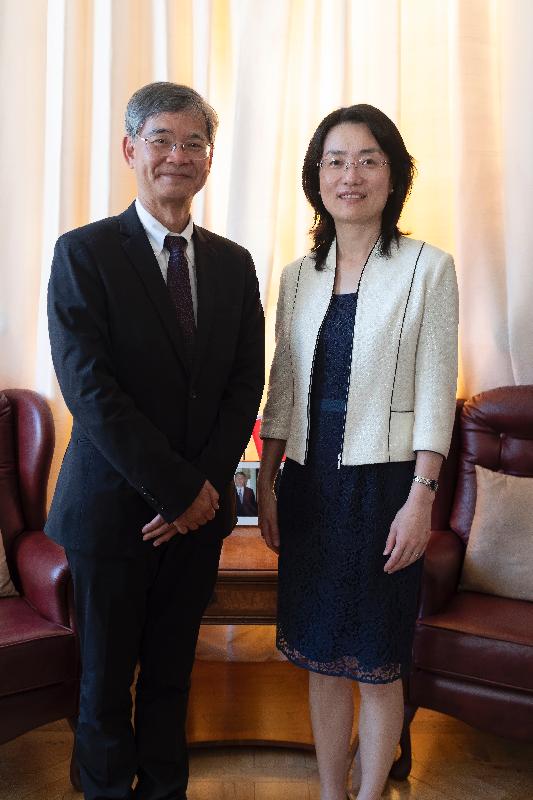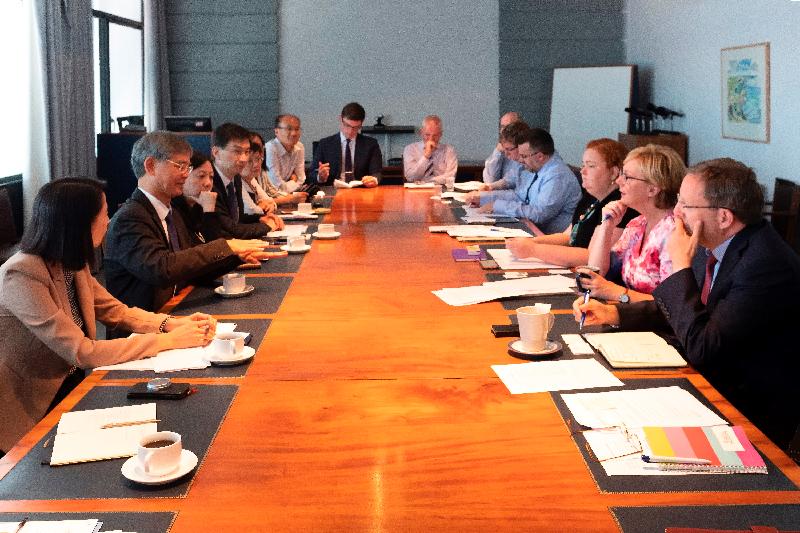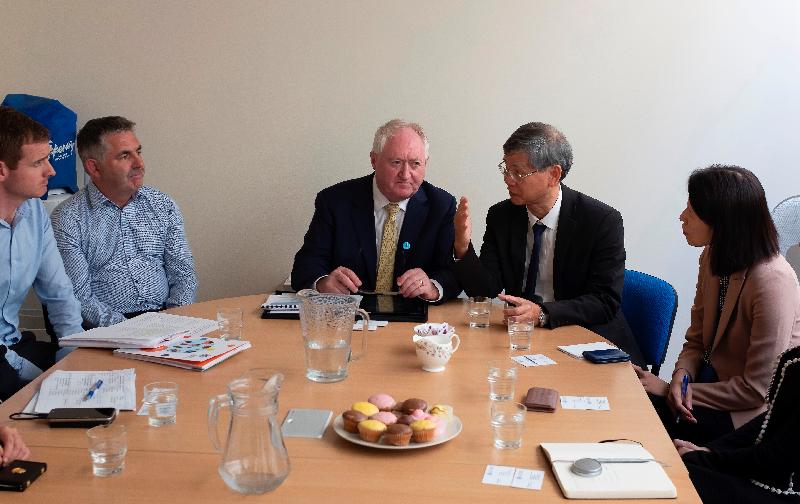LCQ8: Prevention and treatment of cancers
Following is a question by the Hon Kwong Chun-yu and a written reply by the Secretary for Food and Health, Professor Sophia Chan, in the Legislative Council today (July 4):
Question:
In 2014, more than 29 000 new cancer cases were recorded in Hong Kong, representing an increase of 32 per cent as compared with the figure of a decade earlier. The incidence rate of cancers among elderly persons (i.e. persons aged 65 or above) more than doubled that among non-elderly persons. In addition, one of every three deaths was due to cancers. Regarding the prevention and treatment of cancers, will the Government inform this Council:
(1) whether it knows the number of colonoscopy examinations conducted in public hospitals, and the average waiting time (and the relevant figures by hospital cluster) for such examinations, in each of the past three years; if such figures are not available, of the reasons for that;
(2) as an overseas medical organisation, after analysing the outcome of relevant studies, has recently pointed out that there is a downward trend in the age of people suffering from colorectal cancer, and the organisation has recommended that the minimum age of people who should receive colorectal cancer screening be lowered to 45, whether the Government will lower the minimum age of eligible participants of the Colorectal Cancer Screening Pilot Programme from 61 to 45;
(3) whether it has considered launching new subsidy schemes for preventing or diagnosing other types of cancers; if so, of the details;
(4) whether it knows, in respect of the waiting time for patients with cancers listed in the table below in each hospital cluster for receiving the first treatment after diagnosis, (i) the median and (ii) the 90th percentile, as well as (iii) the target set by the Hospital Authority (HA) (set out in tables of the same format as the table below); and
Cluster: _____________
| Cancer |
Waiting time for receiving the first treatment after diagnosis |
||
| (i) | (ii) | (iii) | |
| Colorectal cancer | |||
| Lung cancer | |||
| Breast cancer | |||
| Liver cancer | |||
| Prostate cancer | |||
| Corpus uteri cancer | |||
| Nasopharyngeal cancer | |||
| Thyroid cancer | |||
| Stomach cancer | |||
| Non-Hodgkin lymphoma cancer | |||
(5) given that when cancer patients cannot take, owing to undesirable side effects, the first-line drugs in the Hospital Authority Drug Formulary and the second-line drugs with safety net coverage (by the Samaritan Fund or Community Care Fund) for cancer treatment, they have to take drugs without safety net coverage at their own expenses, whether the Government will request HA to expeditiously include more second-line drugs (including T-DM1 for treating breast cancer) into the safety net so that cancer patients can receive effective treatment; if so, of the details; if not, the reasons for that?
Reply:
President,
My reply to the various parts of the Hon Kwong Chun-yu's question is as follows:
(1) The Hospital Authority (HA) does not keep statistics on the waiting time for colonoscopy examination in public hospitals in the past three years. The table below sets out the number of colonoscopy examinations conducted in HA clusters in each of the past three years:
| Cluster | 2015-16 | 2016-17 | 2017-18 |
| Hong Kong East | 5 621 | 6 241 | 5 997 |
| Hong Kong West | 5 058 | 5 306 | 5 067 |
| Kowloon Central* | 5 335 | 5 369 | 9 044 |
| Kowloon East | 6 492 | 7 458 | 7 594 |
| Kowloon West* | 9 623 | 11 870 | 8 328 |
| New Territories East | 10 744 | 11 727 | 11 948 |
| New Territories West | 6 441 | 7 176 | 7 337 |
| Total | 49 314 | 55 147 | 55 315 |
Note 1:
* Kwong Wah Hospital, Our Lady of Maryknoll Hospital, Tung Wah Group of Hospitals Wong Tai Sin Hospital and the service units in the districts concerned have been re-delineated from Kowloon West Cluster to Kowloon Central Cluster since December 1, 2016. Reports on services/manpower statistics and financial information for the whole 2016-17 financial year (as at March 31, 2017) continued to be based on the previous clustering arrangement (i.e. relevant service units still under Kowloon West Cluster). Reports in accordance with the new clustering arrangement started from April 1, 2017. As such, statistics and financial information could not be directly compared with those for previous years.
(2) The Cancer Expert Working Group on Cancer Prevention and Screening (CEWG) was set up under the Government's Cancer Coordinating Committee to regularly review and discuss the latest scientific evidence, local and worldwide, with a view to making recommendations on suitable cancer prevention and screening for the local population.
In response to the increasing healthcare burden arising from colorectal cancer, the Government launched the Colorectal Cancer Screening Pilot Programme (the Pilot Programme) in September 2016 to subsidise colorectal cancer screening for individuals with "average risk" (Note 2) targeted by the CEWG. The Government will regularise the Pilot Programme and progressively extend it in phases from the current group of persons born in the years from 1946 to 1955 (i.e. persons aged between 61 and 70 when the Pilot Programme was launched in 2016) to cover individuals aged between 50 and 75. The Department of Health (DH) is carrying out the related preparatory work and will announce the details in due course. The CEWG will continue to review local and worldwide scientific evidence, including the latest data and scientific evidence, and will revise or update the recommendations on cancer prevention and screening when necessary.
Note 2: Persons with "average risk" refer to individuals aged 50 to 75 who do not have significant family history. The CEWG recommends that they should consult their doctors and consider to undergo colorectal cancer screening.
(3) In examining whether to introduce a population-based screening programme for a specific disease or cancer, the Government needs to make reference to the CEWG's recommendations and carefully consider a number of factors, including the seriousness and prevalence of the disease locally, accuracy and safety of the screening tests for the local population, as well as effectiveness in reducing disease incidence and mortality. The Government also needs to give due consideration to the actual circumstances, such as the feasibility, equity, cost-effectiveness of the screening programme and public acceptance.
Based on the above principles, apart from the Pilot Programme mentioned in part (2), we are also implementing a screening programme for cervical cancer. The DH, in collaboration with the healthcare sector, launched a territory-wide Cervical Screening Programme in 2004 to encourage women to undergo regular cervical cancer screening. To further help low-income women receive cervical cancer screening, a three-year Community Care Fund Pilot Scheme on Subsidised Cervical Cancer Screening and Preventive Education for Eligible Low-income Women was launched in December 2017, under which three service providers, namely the Centre of Research and Promotion of Women's Health of the Chinese University of Hong Kong, the Family Planning Association of Hong Kong and the United Christian Nethersole Community Health Service, reach out into the community to encourage low-income women to receive free or subsidised cervical cancer screening as well as provide them with health education on prevention of cervical cancer.
In view of the increasing demand on staging imaging for confirmed cancer cases, the HA has implemented since May 2012 the "Project on Enhancing Radiological Investigation Services through Collaboration with the Private Sector" to provide computed tomography and magnetic resonance imaging examinations for selected cancer patients fulfilling pre-defined clinical criteria. The target patient groups of the project have been expanded over the past years to benefit patients of more cancer types. The project currently covers 11 types of cancers, namely colorectal cancer, breast cancer, nasopharyngeal cancer, lymphoma, prostate cancer, stomach cancer, corpus uteri cancer, cervix cancer, head and neck cancer, sarcoma and germ cell tumour.
In fact, risk factors for cancers are closely related to lifestyles. Thus, the DH has been actively promoting healthy diet and regular exercise, and making great efforts to control smoking and educate the public about the harms of alcohol as the primary preventive strategies in reducing the burden caused by non-communicable disease such as cancer on the healthcare system and society. The Government will continue to promote health for all and prevention of diseases, and provide specific health promotion and disease prevention services having regard to the health needs and risks of various age groups and gender.
(4) The HA attaches great importance to the provision of appropriate care for cancer patients, and reviews on a regular basis the waiting time for patients with colorectal cancer, breast cancer and nasopharyngeal cancer to receive their first treatment after diagnosis. The table below sets out the 90th percentile waiting time (Note 3) for such patients to receive their first treatment after diagnosis in the period from 2014-15 to 2016-17:
| 2014-15 (No. of days) |
2015-16 (No. of days) |
2016-17 (No. of days) |
|
| Colorectal cancer | 71 | 70 | 78 |
| Breast cancer | 58 | 63 | 66 |
| Nasopharyngeal cancer | 50 | 50 | 54 |
Note 3: The 90th percentile waiting time refers to the number of days between the date when a patient is diagnosed with cancer after pathological examination and the date when the patient receives his/her first treatment. The waiting time of 90 per cent of such cases is shorter than the value indicated.
As for patients with other types of cancer, the HA does not have relevant statistics on the waiting time for their first treatment.
(5) As the major provider of publicly-funded public healthcare services in Hong Kong, the HA attaches great importance to the provision of appropriate care for all patients, while ensuring an equitable access to and effective use of public resources in the public interest. The HA has an established mechanism to regularly evaluate new drugs and review its Drug Formulary (HADF). In the evaluation process, the HA follows such core values as evidence-based medical practice, rational use of public resources, targeted subsidy, opportunity cost and facilitation of patients' choice, and takes into account the safety, efficacy and cost-effectiveness of drugs and other relevant factors, including international recommendations and practices, advance in technology, disease state, patient compliance, quality of life, actual experience in the use of drugs, and the views of professionals and patient groups.
The Government and the HA understand the financial pressure and burden on cancer patients, as well as the latter's strong aspiration for listing certain new drugs on the HADF and including self-financed items (SFIs) in the subsidy scope of the safety net. Since 2018, the HA has increased the frequency of the prioritisation exercise for including SFIs in the safety net from once to twice a year, so as to shorten the lead time for introducing suitable new drugs to the safety net. The HA will keep abreast of the latest development of clinical treatment and scientific evidence, listen to the views and suggestions of patient groups, and continue to include suitable drugs in the safety net under the established mechanism to benefit more patients in need.


